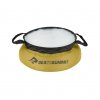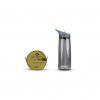- Joined
- Dec 11, 2000
- Messages
- 953
I have one of those PVC military style folding bowls, but it has a melted pin hole half way up the side, so doesn’t get much use. On real trips I use either my large Balti bowl that doubles as eating bowl and sometimes fry pan, or my Snowpeak 900, which doubles as pot, mug and bowl.
When I was on a desert trip with a group, we used sand to scrub food off plates etc, then had a tiny bit of water heavily treated with Dettol to swill in. They had a wash bowl big enough for plates. The Dettol water was quickly brown with the sand residue, but you knew no pathogens were gonna survive.
When I was on a desert trip with a group, we used sand to scrub food off plates etc, then had a tiny bit of water heavily treated with Dettol to swill in. They had a wash bowl big enough for plates. The Dettol water was quickly brown with the sand residue, but you knew no pathogens were gonna survive.





